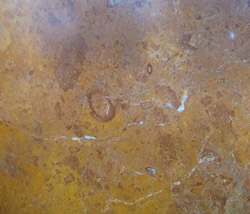Stop 1: Utah State Capitol
Utah’s Capitol building was built between 1913 and 1915, almost 20 years after Utah achieved statehood in 1896. Eight hundred railroad carloads of quartz monzonite (a granite-like stone) from the Little Cottonwood stock in Little Cottonwood Canyon, Salt Lake County were used for the exterior.
Quartz monzonite is very similar to granite but has a different ratio of quartz to feldspar minerals (granite contains more quartz). The Little Cottonwood stock was intruded deep within the earth between 24 and 31 million years ago (during the Oligocene Epoch). Beginning roughly 15 million years ago, the Wasatch Range was gradually uplifted and the quartz monzonite was exposed as the overlying rocks were eroded away.
The Gold Room (State Reception Room), the Supreme Court Chamber, and the House of Representatives are decorated with Birdseye marble, quarried in the Thistle area of Utah County. The attractive brown to golden-brown Birdseye marble is actually a limestone unusually rich in oncolites (small, rounded concretions formed by lime-secreting algae).
This limestone is part of the Flagstaff Limestone formation deposited in the freshwater Paleocene-age (66 to 55 million years old) Lake Flagstaff.
Travertine quarried 4 miles south of Low in the Cedar Mountains of Tooele County, adorns the main vestibule and Senate Chamber. This beige and cream-colored travertine has either a banded or cloudy appearance. It crops out in large veins within the Pennsylvanian/Permian-age Oquirrh Formation (330 to 240 million years old).
The travertine probably started forming during the Basin-and-Range extension in Utah and Nevada, which began roughly 15 million years ago and continues today. Travertine is a finely crystalline limestone formed by the precipitation of calcium carbonate around hot springs, in caves, near waterfalls, and from cold-water solutions.
This travertine has also been called onyx (“ON-ix”) marble. Onyx marble is a dense, usually banded variety of travertine precipitated from cold-water solutions. True onyx is a parallel-banded form of chalcedony, a compact variety of quartz.
Since Birdseye marble and travertine are capable of being polished, they are classified as marble by the building stone industry, but to geologists they are considered varieties of limestone. True marble is limestone that has been metamorphosed or recrystallized.
The walls and corridors of the Capitol’s ground floor, although they have been plastered over, were constructed of white Sanpete oolitic limestone quarried east of Ephraim in Sanpete County (see Hansen Planetarium, stop 11, for more information on this limestone).
Because it was less expensive, gray Georgia marble (Murphy Marble) was used for the floors, walls, stairs, and columns of the interior rotunda. Quarried in the Tate area of north-central Georgia, this Cambrian-age (570 to 500 million years old) marble was originally deposited as carbonate sediment along an ancient barrier reef.
The Capitol sits on roughly 40 acres of landscaped grounds that are maintained as a public park. The Capitol is open daily from 6:00 a.m. to 6:00 p.m.; guided tours are provided every half hour from 9:00 a.m. to 4:00 p.m. weekdays.
Cross 300 North in front (south) of the Capitol to the next stop at Council Hall.
PI-60 Building Stones of Downtown Salt Lake City, A Walking Tour



















